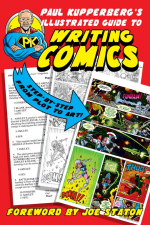 Paul Kupperberg’s Illustrated Guide to Writing Comics is coming to Kickstarter today! After writing about 1,400 stories for DC Comics, Archie, Bongo Comics, Marvel, Charlton, and other publishers, not to mention editing hundreds more during his 16 years as an editor for DC Comics, one of the few things he does know is how to write a comic book story.
Paul Kupperberg’s Illustrated Guide to Writing Comics is coming to Kickstarter today! After writing about 1,400 stories for DC Comics, Archie, Bongo Comics, Marvel, Charlton, and other publishers, not to mention editing hundreds more during his 16 years as an editor for DC Comics, one of the few things he does know is how to write a comic book story.
First Comics News: Is this a book, magazine or comic?
Paul Kupperberg: Paul Kupperberg’s Illustrated Guide to Writing Comics, the newest publication from Charlton Neo Media, is a full-fledged 126-page black and white book, with words and pictures.
1st: Who is this book intended for?
Paul: Like most how-to guides, it’s largely aimed at aspiring and beginning writers, but I hope that it also contains something for the more experienced writer as well. I’m flattered that more than one of my professional colleagues have told me they intend to pick the book up.
1st: How much about writing a story do you need to know to use this book?
 Paul: I don’t think it’s so much about knowing how to write a story than actually having a story to tell that you want to write. A lot of new writers are good at coming up with plots—“Boy meets girl. Boy loses girl. Boy gets girl.”—but have no idea how to build a story around it, that is, populating their tale with compelling and believable characters. Plot is what happens; story is why, and if you do have a story a tell, I take you through my personal creative process in developing those skills.
Paul: I don’t think it’s so much about knowing how to write a story than actually having a story to tell that you want to write. A lot of new writers are good at coming up with plots—“Boy meets girl. Boy loses girl. Boy gets girl.”—but have no idea how to build a story around it, that is, populating their tale with compelling and believable characters. Plot is what happens; story is why, and if you do have a story a tell, I take you through my personal creative process in developing those skills.
1st: How do you illustrate writing?
Paul: In the case of Paul Kupperberg’s Illustrated Guide to Writing Comics, with over 100 illustrations that show the progress of creating a comic book story from literally scribbled steno-pad notes for story ideas to typed plots and scripts and the resulting finished comic book pages.
1st: Does this teach both full script and Marvel style?
 Paul: I go through both methods, pointing out their respective pros and cons (personally, I prefer full script; it allows the writer to maintain control of the pace of the story). I even briefly cover writers who write illustrated scripts, breaking the page down into panels and drawing little stick figures instead of writing panel descriptions. That method’s much more common in humor comics. In fact, the first time I met Archie artist Stan Goldberg was after he had drawn a few of my scripts, and as we shook hands, he said, “You’re the one who uses all the words.”
Paul: I go through both methods, pointing out their respective pros and cons (personally, I prefer full script; it allows the writer to maintain control of the pace of the story). I even briefly cover writers who write illustrated scripts, breaking the page down into panels and drawing little stick figures instead of writing panel descriptions. That method’s much more common in humor comics. In fact, the first time I met Archie artist Stan Goldberg was after he had drawn a few of my scripts, and as we shook hands, he said, “You’re the one who uses all the words.”
1st: If you are already a comic writer will this help you improve your craft?
Paul: I’d like to think so. I mean, writers should always be evolving and trying to get better at telling their stories, and it doesn’t matter where you find the inspiration or personal creative truth. I’m constantly reading books on how to write, and not just comics. For a writer, there’s no such thing as useless knowledge or information. If you’re not constantly learning, you’re not developing as a writer.
 1st: Do you teach techniques for developing characters?
1st: Do you teach techniques for developing characters?
Paul: First thing! Without solid, believable characters, a writer hasn’t got anything to work with because story needs to flow from the characters. If you put Superman and Spider-Man into the exact same predicament, they’ll handle it in completely different ways, each according to their personalities. It’s not the gimmick or the superpower that draws readers to your story. It’s the character.
1st: Do you explain how to establish world-building?
Paul: Right there, in Chapter Two: Reality in the Comic Book Universe.
1st: Is their only one way to write a comic?
Paul: There are as many ways to write a comic as there are writers writing comics. Everyone has their own way of writing, and not just stylistically. I was influenced by a lot of writers, especially at the start of my career. And by “influenced,” I mean I shamelessly ripped them off, finding the bits and pieces of their methods or styles that I liked and integrating them into my own work. Eventually, I adapted and added those bits and pieces to my own personal bag of tricks, and, years later, something that I recognized as my own style emerged from it all. I found my way of writing, just like everybody eventually does.
1st: How do you take ideas from words to art?
 Paul: Practice! But the book has an appendix, “One Story, From Concept to Completion,” showing the development of a new character, Douglas “Digger” Graves, Paranormal P.I. (and son of classic Charlton horror host, Dr. Graves) and the ten-page story by artist Andrew Mitchell that resulted from the moment the idea occurred, through character development and character sketches, all the way through the script to finished art.
Paul: Practice! But the book has an appendix, “One Story, From Concept to Completion,” showing the development of a new character, Douglas “Digger” Graves, Paranormal P.I. (and son of classic Charlton horror host, Dr. Graves) and the ten-page story by artist Andrew Mitchell that resulted from the moment the idea occurred, through character development and character sketches, all the way through the script to finished art.
1st: How do you explain the space you need for lettering to the artist?
Paul: I don’t. But award-winning letterer Todd Klein (Sandman, America’s Best Comics) does in a special sidebar, “Preparing Comic Book Scripts for Lettering.”
1st: Is this all Paul Kupperberg’s ideas or do you have colleagues contributing as well?
Paul: Mostly me, but I did reach out to different writers, artists, letterers, and editors in the business and I feature the advice of Pat Brosseau, Janice Chiang, Steve Erwin, Tom DeFalco, Danny Fingeroth, Robert Greenberger, Rick Hoberg, Todd Klein, Stuart Moore, Michael Avon Oeming, Rick Parker, Clem Robins, Alex Segura, Rick Stasi, and Darren Vincenzo on every aspect of the creative process, from creation to what editors look for in new projects.
1st: What is the minimum pledge for a PDF?
 Paul: $10 gets you a PDF copy of Paul Kupperberg’s Illustrated Guide to Writing Comics.
Paul: $10 gets you a PDF copy of Paul Kupperberg’s Illustrated Guide to Writing Comics.
1st: What is the minimum pledge for a physical copy?
Paul: For $20, you get a digital and print copy of Paul Kupperberg’s Illustrated Guide to Writing Comics.
1st: What type of rewards do you have planned?
Paul: In addition to print and digital copies of the book, we’re offering prints, stickers, a t-shirt, a reprint of Nick Cuti’s 1973 Charlton Comic Book Guide for the Writer, Artist, and Letterer, vintage signed copies of my comic book work, and signed comic book scripts.
1st: How much of the project is complete?
 Paul: The book is 100% complete and ready to go to the printer as soon as we’re funded!
Paul: The book is 100% complete and ready to go to the printer as soon as we’re funded!
1st: When can they expect the book to ship?
Paul: The Kickstarter’s end date is April 3, which is the 45th anniversary of my first professional comic book sale (to Charlton editor Nick Cuti, which appeared in Scary Tales #3 as “Distress”), so I expect we’ll be ready to ship sometime in May, as soon as Kickstarter settles up and we get the finished book to the printer.
1st: What makes this project so cool no aspiring comic writer should miss it?
Paul: Well, I’ve managed to survive 45 years in the comic book business, writing about 1,400 stories for a wide variety of publishers, a career that’s spanned writing the first comic book miniseries (DC’s World of Krypton) and the “Death of Archie” storyline. I must have learned something by now!
1st: What is the Kickstaters URL?
Paul: You can check out and back the project at:
Kickstarter.com
And for a little deeper look at what’s inside Paul Kupperberg’s Illustrated Guide to Writing Comics:
MortTodd.com
